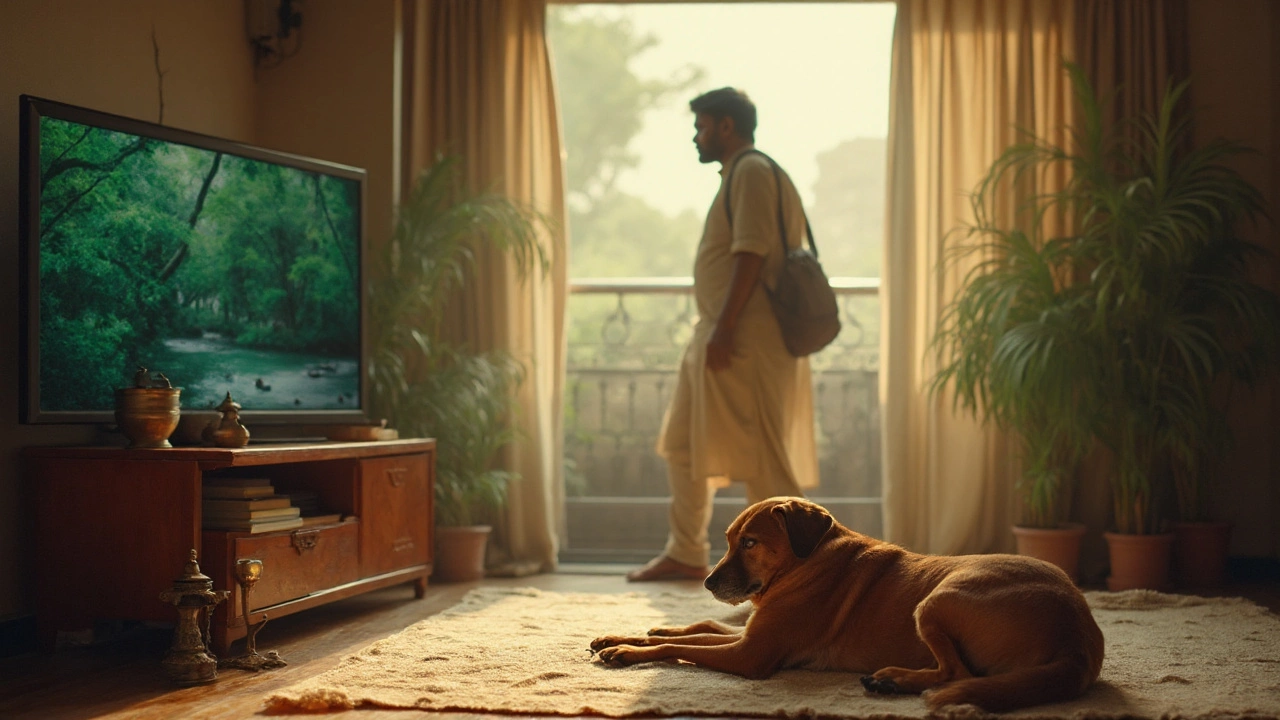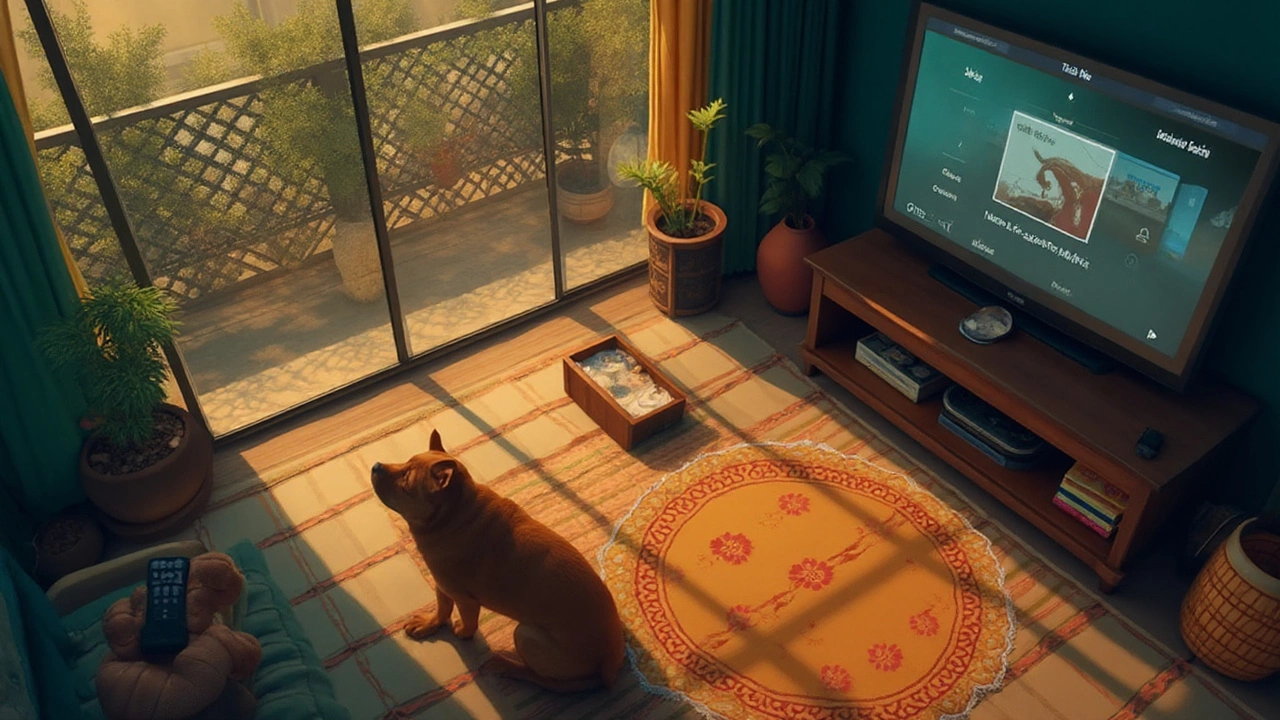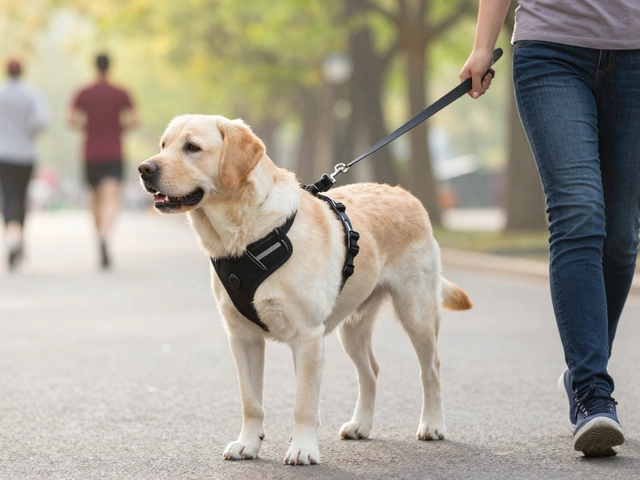
TL;DR
- Yes-TV or audio can help some dogs by masking outside noises and offering mild company; it won’t fix true separation anxiety on its own.
- Pick calm sound (classical, soft rock, nature), low volume (about quiet conversation), and avoid animal-heavy visuals that trigger barking.
- Test for two weeks: record your dog, track stress signs, and compare to quiet days.
- If your dog panics when you leave, you need gradual alone-time training and likely a vet/behaviour consult.
- Radio, audiobooks, or white/brown noise often work as well as TV with lower energy use and fewer triggers.
What TV Actually Does for Dogs (and what it can’t)
Here’s the honest answer: TV can help some dogs feel steadier when they’re home alone because it softens outside sounds and adds a bit of predictable background life. But it’s not a cure for separation anxiety. Think of it like white paint on a fence-it looks nicer, but it won’t stop the panels falling if the posts are rotten.
Why can it help at all? Background audio masks the unpredictable spikes that set many dogs off: couriers, hallway footsteps, car doors, kids at the letterbox. When the soundscape is constant and gentle, those spikes don’t stand out as much. That can mean less alert barking, less pacing, and more napping.
What does the science say? A few solid studies looked at sound, not TV pictures specifically. In a shelter study (Animal Welfare, 2002), Wells, Graham, and Hepper reported that classical music reduced barking and restlessness compared with pop, talk radio, or silence. Kogan et al. (Journal of Veterinary Behavior, 2012) found kenneled dogs lay down more and barked less with classical compared with heavy metal. Bowman and colleagues (Physiology & Behavior, 2015, Scottish SPCA/University of Glasgow) even saw benefits from reggae and soft rock-heart-rate variability suggested calmer states. The theme is consistent: gentle, predictable audio helps many dogs settle.
Do dogs actually watch TV? Some do. Modern screens refresh fast enough that many dogs perceive the images, and certain individuals react to animals on screen. But the soothing effect comes mostly from sound, not visuals. For easily triggered dogs, the pictures can backfire (more on that below).
What it can’t do: TV won’t resolve real separation distress-panting, drooling puddles, door-scratching, escape attempts, or repetitive howling right after you leave. Those cases need desensitisation training, and sometimes medication prescribed by a vet. Background sound can support that plan, but it can’t replace it.
Quick decision rule you can use today:
- If your dog is mostly fine but barks at outside noises → TV or audio is worth trying.
- If your dog panics when you leave (big signs of distress) → start a separation training plan; use TV only as a helper, not the main fix.
- If your dog reacts to animals on screen → prefer radio, audiobooks, or brown noise over TV visuals.
Local angle if you’re in NZ: apartments and townhouses here in Auckland carry sound. A bit of steady audio can reduce reactive barking to neighbour comings-and-goings and save you a body-corp complaint. But keep the volume sensible so you don’t just move the problem next door.

How to Set It Up the Right Way (content, volume, routine)
You’re doing this to lower stress and cut triggers, not to entertain your dog with car chases. Keep it simple and controlled. Here’s a practical setup that takes 10 minutes.
Step-by-step (do this for two weeks):
- Pick your medium. TV is fine, but radio, a smart speaker, or a white/brown noise track usually works as well-sometimes better. If your dog barks at animals on screen, skip visuals.
- Choose calm content. Classical, soft rock, or soft reggae are supported by studies (Animal Welfare 2002; Physiology & Behavior 2015). A gentle nature soundtrack works too. Avoid talk radio with sudden ads, laugh tracks, or crowd noise.
- Set the volume. Aim for quiet-conversation level at your dog’s bed, roughly 40-50 dB. A phone decibel app makes this easy. If you can clearly hear it from the hallway, it’s too loud.
- Place the speaker/screen. Point it away from doors or windows so it doesn’t draw attention to outside sounds. Keep cables out of reach and the TV stable. If crated, don’t face the screen directly at your dog-off to the side is kinder.
- Use a timer. Start the audio 10-15 minutes before you leave; let it run the whole absence. Auto-off when you’re home.
- Record and compare. Use a cheap pet cam or your laptop to record the first hour and some random segments later. Log barking, pacing, settling, and when it happens.
What to play (and what to avoid):
- Good bets: classical playlists without sudden crescendos; soft rock/reggae mixes around 60-80 BPM; “brown noise” (deeper than white noise); gentle nature ambiences without animal calls.
- Maybe: audiobooks with calm narrators. Choose steady pacing and a neutral voice, no thrillers with jump scares.
- Avoid: dog videos with barking; wildlife shows with squeaks/calls; news channels; high-drama sports; heavy metal; pop with shouty ads; doorbells in any soundtrack.
How long to run it? For full absences. Switching it on only when you leave can become a “leaving cue.” Better: have it on during parts of the day when you’re home too, so the sound doesn’t scream “you’re about to be alone.”
Energy, cost, and neighbour-friendly settings (NZ context):
| Option | Typical energy use | Pros | Cons | Best for | Est. 8h cost (NZD) |
|---|---|---|---|---|---|
| TV (LED, 40-55") | 50-120 W | Easy, timer apps, many content choices | Visual triggers, higher power than audio-only | Dogs OK with visuals; masking outside noise | $0.12-$0.29 (at ~$0.30/kWh) |
| Radio | 3-10 W | Low energy, simple, no visuals to trigger | Ads can spike; talk radio can be jumpy | Most dogs; apartments | $0.01-$0.02 |
| Smart speaker | 3-7 W | Set playlists, voice control, routines | Needs Wi‑Fi; beeps if notifications | Music/ambient loops | $0.01-$0.02 |
| White/brown noise machine | 3-8 W | Very steady; masks street noise well | No “company” feel; some dogs prefer melody | Noise-reactive dogs | $0.01-$0.02 |
| Fan on low | 10-30 W | Cheap, adds airflow, constant sound | Seasonal, not musical | General masking + cooling | $0.02-$0.07 |
Numbers are ballpark for modern devices. Auckland retail electricity averages roughly $0.28-$0.35/kWh in 2025, so a mid-size LED TV for an 8-hour workday costs about 20-30 cents. If cost or energy matters, audio-only wins without sacrificing the calming effect.
Checklist to get it right:
- Pick 1-2 playlists and stick with them; don’t hop around daily.
- Volume set to “quiet conversation” at your dog’s bed (40-50 dB).
- No doorbells, sirens, barking, or squeaky wildlife.
- Set a smart plug or timer so it’s on before you leave.
- Record the first hour the first 3-4 days; adjust based on what you see.
- Pair with one food-based enrichment (frozen Kong, lick mat). Sound + lick = more settling.
What if your dog is noise-reactive? Start with brown noise at very low volume. Bring music in later if they’re doing well. If your dog startles at sound shifts, use files that don’t change track or volume for hours.
What if your dog glues themselves to the TV or chases the screen? That’s your sign to go audio-only. Visual fixation often raises arousal, which is the opposite of what you want for rest.
Two-week trial plan (super short):
- Days 1-3: Brown noise on low + one food toy; 30-90 minute absences. Record.
- Days 4-7: Add calm music; slightly longer absences. Record.
- Days 8-14: Keep what worked best; test one day with silence as a control to confirm the effect.
Evidence notes for the keen: the studies above used shelter/kennel environments. Homes are quieter and more predictable, so you may see a smaller effect-but the direction tends to be the same. If you want to read the work, look for Wells et al., Animal Welfare (2002); Kogan et al., Journal of Veterinary Behavior (2012); Bowman et al., Physiology & Behavior (2015).

Measure Results, Fix Problems, and Safer Alternatives
This is where people go wrong-they set the TV, hope for the best, and never check if it’s doing anything. A quick measurement loop makes the difference between wishful thinking and something that actually helps your dog.
How to tell if it’s working:
- Video tells the truth. You want to see more time lying down, longer naps, fewer startle reactions at outside noises, and shorter barking bursts (or none).
- Compare “TV days” vs “quiet days.” Keep everything else the same for a fair test.
- Check the first 10-20 minutes after you leave. If stress spikes there, background sound won’t fix it alone-you need a separation plan.
Simple scoring grid you can use (0-2 each):
- Barking: 0 = none; 1 = occasional short barks; 2 = frequent or long bouts
- Pacing: 0 = mostly resting; 1 = some pacing; 2 = frequent pacing
- Settling time: 0 = lies down within 5 minutes; 1 = 5-15 minutes; 2 = 15+ minutes
- Startle to outside noise: 0 = no reaction; 1 = quick ear flick/lift; 2 = up and alert/bark
Add them up; a lower score on audio days means you’re onto something.
Common problems and fixes:
- My dog barks at animal noises on TV → Switch to audio-only, or use ambient tracks without animal calls.
- My dog is fine for an hour, then gets restless → Use longer-lasting food enrichment at the start (frozen Kong), and run steadier audio (brown noise) for the later hours.
- Neighbours complain about sound → Drop to 35-40 dB at the dog bed, aim speakers inward to a soft surface, and skip bass-heavy content.
- Dog ignores food when I leave → That’s a red flag for separation anxiety. Start a desensitisation plan and talk to your vet.
When TV/audio is not enough (or wrong):
- Clear separation anxiety: vocalising, destruction near exits, drooling puddles, self-injury. You need a gradual alone-time protocol and often medical support. The ASPCA and AVMA outline these signs and recommend behaviour plans built on desensitisation.
- Noise phobia (thunder, fireworks): background sound can help mask booms, but you’ll likely need a full noise plan (safe room, counterconditioning, sometimes meds). RSPCA and SPCA NZ both recommend early vet involvement for noise phobias.
Safer alternatives and complements:
- Food enrichment: a stuffed Kong, Toppl, or lick mat slows the first 20-40 minutes-a key window when many dogs struggle most. Pair with your chosen audio.
- Scent-based enrichment: scatter-feeding, snuffle mats, cardboard box “forage” games before you leave.
- Pre-leave routine: short sniffy walk + 10 minutes of calm at home; then leave. Don’t hype your dog up with fetch right before you go.
- Training: “settle on a mat,” and “independent rest” exercises when you are home so your dog practises being calm without constant attention.
- Day care or a trusted walker: for high-energy or social butterflies, twice a week can take the edge off.
Mini-FAQ
- Will blue light or TV damage my dog’s eyes? No evidence at normal home use. If you run TV at night, use night mode to keep the room dim so your dog sleeps.
- Is silence better for some dogs? Yes. If your dog sleeps like a rock in silence and only startles when you add sound, skip the sound. The goal is calm, not gadgets.
- Is music really better than talk radio? Often, yes. Music with stable tempo and low variation tends to work best in studies. Talk can have sudden laughs, ads, or crowd noise.
- What about “dog TV” channels? Some dogs like them; some get over-aroused. Trial it and record. If your dog stares, pants, or scans the room, switch to audio-only.
- Could this make separation worse by becoming a crutch? Not if you make it part of normal life, not just a leaving cue. Run it at random times when you’re home too.
Quick decision guide
- If your dog is mostly relaxed but alert-barks: try leaving TV on for dogs or, better, radio/smart speaker + calm playlist.
- If your dog panics when you leave: do a separation plan; use audio as background only.
- If your dog chases screens or barks at animals: go audio-only; pick brown noise or classical.
- If neighbours complain: drop to 40 dB, reposition speakers, choose brown noise.
Examples (real-world setups that work):
- Apartment in Auckland CBD: smart speaker with brown noise at 40 dB + frozen Kong at departure; timer from 8 a.m. to 5 p.m. Result: reduced hallway-triggered barking to near zero.
- Townhouse with delivery traffic: TV on “slow TV” nature with no animal vocalisations + soft rock playlist. Speakers angled into the room. Result: longer midday naps, fewer postie-triggered barks.
- Noise-reactive rescue: white-noise machine on “brown” at very low volume; zero visuals. Result: fewer startles, calmer first hour alone.
Risks and how to avoid them:
- Chewing cables or knocking the TV: secure cords in a cable sleeve, mount the TV, or use small speakers on a high shelf.
- Overstimulation: if your dog is wide-eyed, panting, or pacing with the TV on, it’s too much. Lower volume or switch to steady audio.
- Unintended cues: if the only time music plays is when you leave, it can become a “you’re going now” signal. Run it sometimes when you’re home.
- Power and fire safety: use modern devices in good condition, avoid overloading power boards, use timers, and keep ventilation clear.
Training add-on for dogs who struggle when you leave (bare-bones version):
- Pick a settling mat. Reward calm on the mat while you’re home (chews, gentle praise).
- Door routine without leaving: pick up keys, sit down again. Repeat until your dog stops reacting.
- Micro-absences: step out for 5-30 seconds, return before your dog gets uneasy. Do a few sets daily.
- Increase in tiny bites: add 10-30 seconds per session across days. If your dog gets up or vocalises, back up to an easier duration.
- Layer the audio in all sessions so it becomes background, not a leaving cue.
Credible sources to back you up: Wells, Graham, & Hepper, Animal Welfare (2002) showed classical music reduced shelter barking; Kogan et al., Journal of Veterinary Behavior (2012) found similar effects in kenneled dogs; Bowman et al., Physiology & Behavior (2015) with the Scottish SPCA reported reduced stress markers with reggae/soft rock. For separation anxiety recognition and treatment, see veterinary guidelines from the AVMA and ASPCA. SPCA NZ promotes enrichment and environmental management but recommends veterinary input for true distress cases.
Next steps
- Set up a two-week trial with one calm playlist and one steady ambient option; record and score your dog’s behaviour.
- If you see no improvement-or if you see panic in the first 10-20 minutes-start a separation programme and book a vet/behaviour consult.
- Keep what works, set it on a timer, and make it part of your normal home soundscape, not just your leaving routine.
Troubleshooting by scenario:
- Puppy (under 6 months): prioritise sleep. Use very low-volume brown noise. Short absences and a safe pen. Avoid flashy visuals. Focus on calm independence training.
- Senior dog with hearing loss: visuals won’t help; use lower-frequency brown noise (easier to feel) and comfy bedding. Keep volume low to avoid startling.
- Dog who panics at storms: build a safe room (interior, curtains closed), run brown noise + fan, and talk to your vet about a storm plan well before Guy Fawkes or New Year’s.
- Shift worker: use blackout curtains, white/brown noise, and a food puzzle. Keep routine times consistent even if days vary.
- Multi-dog home: test each dog alone first; some love melody, others need steady noise. If one reacts to TV, default to audio-only.
Bottom line: yes, TV or audio can be part of a calmer home-alone setup for many dogs, mainly by masking life’s random noises. But if your dog is distressed about you leaving, media won’t solve that by itself. A clear plan, a bit of training, and a steady soundscape beat wishful thinking every time.





